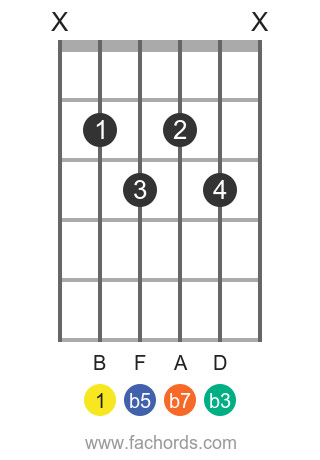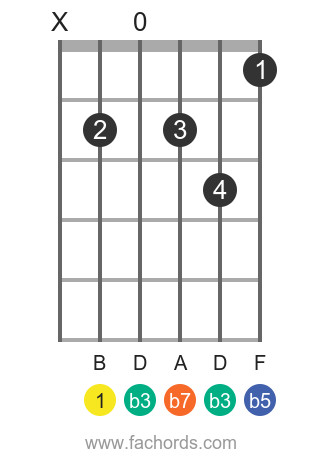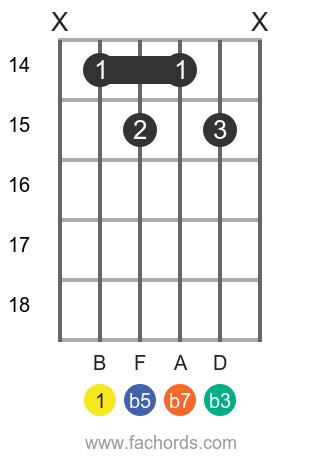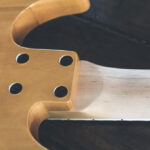Welcome to your guide to the Bm7b5 Guitar Chord, a captivating and crucial chord in the realm of diminished harmony. Often referred to as B minor 7 flat 5, this chord, built from the notes B, D, F, and A, adds a distinctive color to your guitar playing and opens doors to more sophisticated musical expressions.
The Bm7b5’s unique character stems from its specific intervallic structure: the root (1), minor third (b3), diminished fifth (b5), and minor seventh (b7). These intervals combine to create a sound that is both intriguing and slightly dissonant, a hallmark of the diminished chord family. If you’re looking to delve deeper into the theory behind chord construction, exploring resources on fretboard intervals and guitar chord notation can significantly enhance your understanding.
This chord belongs to the diminished family, known for their tense and unresolved sound. They are frequently employed to create harmonic tension, often resolving to more stable chords and adding depth to genres like jazz, blues, and even pop music. To broaden your knowledge of this chord family, our tutorial on diminished guitar chords is an excellent resource.
In this lesson, we’ll provide you with essential chord diagrams and fretboard patterns for the Bm7b5. Understanding how chords are constructed is key to musical fluency, and our guide on building chords by stacking intervals offers valuable insights into this process. Let’s unlock the potential of the Bm7b5 chord and enrich your guitar vocabulary.
Deconstructing the Bm7b5 Chord: Notes and Structure
The Bm7b5 chord is composed of these notes:
- B (Root)
- D (Minor Third)
- F (Diminished Fifth)
- A (Minor Seventh)
Its structure in terms of intervals from the root is:
- 1 (Root)
- b3 (Minor Third)
- b5 (Diminished Fifth)
- b7 (Minor Seventh)
This combination of intervals gives the Bm7b5 its characteristic diminished sound, often described as melancholic or suspenseful.
Playing the Bm7b5 Chord: Chord Diagrams and Positions
Below are several positions to play the Bm7b5 chord on the guitar, ranging from easier to more challenging fingerings. Remember to learn how to read chord diagrams if you’re new to them. If barre chords present a challenge, our Bar Chords Tips tutorial can provide valuable assistance. For a text-based version of these diagrams, visit our accessible chords page.
Position 1: Movable Shape
This is a movable shape, meaning you can slide it up and down the neck to play different m7b5 chords.
 B m7b5 position 3 guitar chord diagram
B m7b5 position 3 guitar chord diagram
Alt text: B minor 7 flat 5 guitar chord diagram position 1, movable shape with root on the 6th string, ideal for exploring different voicings along the fretboard.
Position 2: Movable Shape
Another movable position, offering a different voicing of the Bm7b5 chord.
 B m7b5 position 4 guitar chord diagram
B m7b5 position 4 guitar chord diagram
Alt text: B minor 7 flat 5 guitar chord diagram position 2, movable shape with root on the 5th string, providing an alternative fingering for smooth chord transitions.
Position 3: Open Position
This position utilizes open strings, making it a slightly easier fingering.
 B m7b5 position 1 guitar chord diagram
B m7b5 position 1 guitar chord diagram
Alt text: B minor 7 flat 5 guitar chord diagram open position, position 3, incorporating open strings for a resonant and accessible voicing of the chord.
Position 4: Barre Chord Shape
A barre chord variation, also movable, requiring more finger strength but providing a full sound.
 B m7b5 position 2 guitar chord diagram
B m7b5 position 2 guitar chord diagram
Alt text: B minor 7 flat 5 guitar chord diagram position 4, barre chord shape, movable and powerful voicing for a rich Bm7b5 sound across the neck.
Explore more chord shapes in our comprehensive all guitar chords library. For a printable resource, download our Free Guitar Chords Chart Pdf.
Experimenting with Bm7b5 and Beyond
To practice the Bm7b5 chord in context, try incorporating it into common chord progressions. It often functions as a ii chord in minor key progressions, leading to the V chord. For example, in the key of A minor, a progression could be: Am – Dm7b5 – G7 – CM7.
You can also explore playing m7b5 chords with different roots by using the movable shapes presented above. Here are a few to get you started:
C m7b5 | D m7b5 | E m7b5 | F m7b5 | G m7b5 | A m7b5 | B m7b5 | C#m7b5 | D#m7b5 | F#m7b5 | G#m7b5 | A#m7b5 | Abm7b5 | Bbm7b5 | Dbm7b5 | Ebm7b5 | Gbm7b5
Remember, understanding the notes within the chord allows you to create your own fingerings anywhere on the fretboard. Use the fretboard map provided in our resources to visualize the chord tones and expand your improvisational possibilities.
Conclusion
Mastering the Bm7b5 guitar chord unlocks a world of expressive possibilities in your playing. From its unique diminished sound to its crucial role in chord progressions, this chord is a valuable addition to any guitarist’s toolkit. Practice these shapes, explore its use in different musical contexts, and continue to deepen your understanding of guitar theory. Happy playing!

